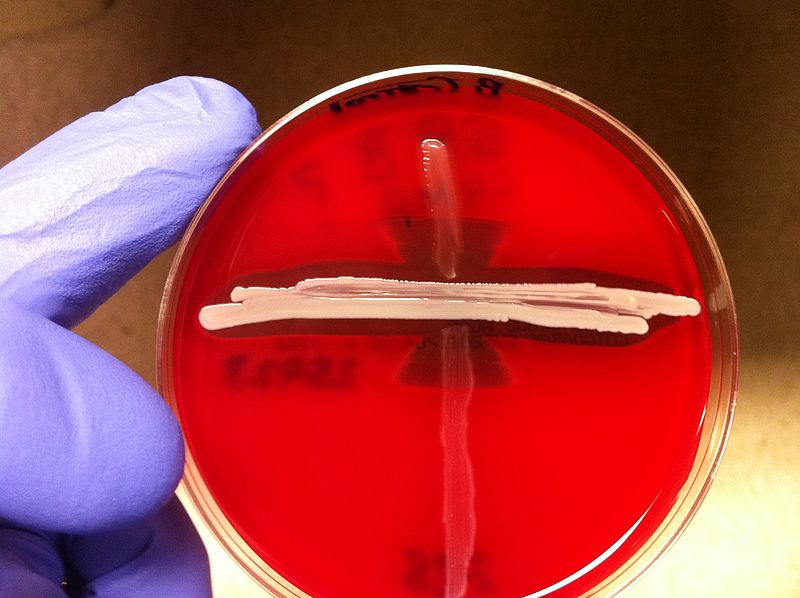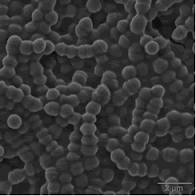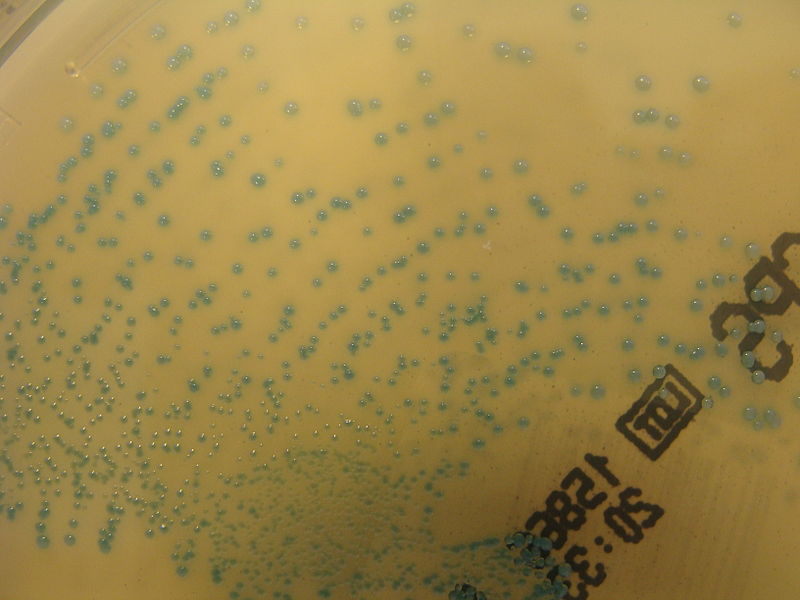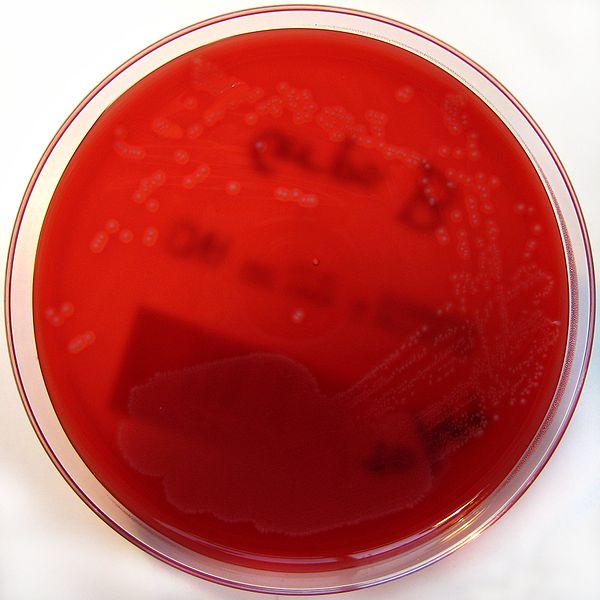Group B streptococcal infection causes: Difference between revisions
No edit summary |
|||
| Line 57: | Line 57: | ||
==Antimicrobial therapy== | ==Antimicrobial therapy== | ||
Streptococcus agalactiae treatment <ref>{{cite book | last = Bartlett | first = John | title = Johns Hopkins ABX guide : diagnosis and treatment of infectious diseases | publisher = Jones and Bartlett Learning | location = Burlington, MA | year = 2012 | isbn = 978-1449625580 }}</ref> | :* Streptococcus agalactiae treatment <ref>{{cite book | last = Bartlett | first = John | title = Johns Hopkins ABX guide : diagnosis and treatment of infectious diseases | publisher = Jones and Bartlett Learning | location = Burlington, MA | year = 2012 | isbn = 978-1449625580 }}</ref> | ||
::* (1) Bacteremia, soft tissue infections | |||
:::* Preferred regimen: [[Penicillin G]] 10-12 MU/day for 10 days [e.g., give 2 MU q4h or six divided doses/day]. | :::* Preferred regimen: [[Penicillin G]] 10-12 MU/day for 10 days [e.g., give 2 MU q4h or six divided doses/day]. | ||
| Line 74: | Line 74: | ||
:::: Note (3): [[Clindamycin]] can be considered, but rates of resistance vary. Consider confirming absence of inducible [[Clindamycin]] resistance (typically associated with macrolide resistance) before using as monotherapy. | :::: Note (3): [[Clindamycin]] can be considered, but rates of resistance vary. Consider confirming absence of inducible [[Clindamycin]] resistance (typically associated with macrolide resistance) before using as monotherapy. | ||
:::: Note (4): Streptococcus agalactiae causes neonatal sepsis or meningitis, puerperal sepsis, chorioamnionitis; also bacteremia (often without clear source), skin and soft-tissue infections, septic arthritis. Found in gastrointestinal,genitourinary tracts. More common in adults >65 years and those with comorbidities. | :::: Note (4): Streptococcus agalactiae causes neonatal sepsis or meningitis, puerperal sepsis, chorioamnionitis; also bacteremia (often without clear source), skin and soft-tissue infections, septic arthritis. Found in gastrointestinal,genitourinary tracts. More common in adults >65 years and those with comorbidities. | ||
==References== | ==References== | ||
Revision as of 15:01, 29 June 2015
|
Group B Streptococcal Infection Microchapters |
|
Differentiating Group B Streptococcal Infection from other Diseases |
|---|
|
Diagnosis |
|
Treatment |
|
Case Studies |
|
Group B streptococcal infection causes On the Web |
|
American Roentgen Ray Society Images of Group B streptococcal infection causes |
|
Directions to Hospitals Treating Group B streptococcal infection |
|
Risk calculators and risk factors for Group B streptococcal infection causes |
Editor-In-Chief: C. Michael Gibson, M.S., M.D. [1]; Associate Editor(s)-in-Chief: Rim Halaby, M.D. [2]
Overview
Group B Streptococcus (GBS) disease is caused by the infection with the bacterium GBS which is a beta hemolytic gram-positive streptococcus characterized by the presence of group B Lancefield antigen. GBS displays beta-hemolysis when cultured on a blood agar plate and produces zones of hemolysis that are only slightly larger than the colonies themselves. The species other name S. agalactiae, where "agalactiae" means "no milk", alludes to this. GBS hydrolyzes sodium hippurate and gives a positive response in the CAMP test. GBS is also sensitive to bile and will lyse in its presence. GBS is a species of the normal flora of the gut and female urogenital tract. The polysaccharide antiphagocytic capsule is this bacterium's main virulence factor.
Taxonomy
Cellular organisms; Bacteria; Firmicutes; Bacilli; Lactobacillales; Streptococcaceae; Streptococcus
Biology
GBS is characterized by the following features:
- Gram-positive
- Cocci in pairs and short chains
- Group B Lancefield antigen
- Non-motile
- Catalase-negative
- Non-spore forming
- Polysaccharide antiphagocytic capsule (main virulence factor)
- Surface proteins
- Beta hemolysis
Identification
The CAMP test is an important test for identification. GBS are screened through this test. It is characterized by the presence of Lancefield antigen and by its ability to hydrolyze sodium hippurate.
GBS is also sensitive to bile, and will lyse in its presence.
Shown below is an image depicting an example of a positive CAMP test proving that GBS is present. The arrowhead formation on the Blood agarose gel, BAP (5% sheep blood) indicates that this bacteria is GBS.
Shown below is an image depicting colonies of GBS under microscope.
Shown below is an image depicting the growth of colonies of GBS on ChromID CPS chromogenic agar.
Shown below is an image depicting the growth of colonies of GBS on Columbia horse blood agar.
Gallery
-
Right elbow of a patient with group B Streptococcus (GBS) bacteremia, with localized edema and erythema. From Public Health Image Library (PHIL). [1]
-
Group-B streptococci (GBS) identified by CAMP test, which takes advantage of the capacity of GBS to produce this CAMP factor that most other hemolytic streptococci do not produce. From Public Health Image Library (PHIL). [1]
-
Quantitative difference in hemolytic reactivity seen on BAP with group-D Streptococci (left wedge), group-B Streptococci (middle wedge), and group-A Streptococci (right wedge) bacteria. From Public Health Image Library (PHIL). [1]
-
Clindamycin-resistant Group-B Streptococcus (GBS), also known as S. agalactiae. From Public Health Image Library (PHIL). [1]
Treatment
Antimicrobial therapy
- Streptococcus agalactiae treatment [2]
- (1) Bacteremia, soft tissue infections
- Preferred regimen: Penicillin G 10-12 MU/day for 10 days [e.g., give 2 MU q4h or six divided doses/day].
- (2) Meningitis (Adult)
- Preferred regimen: Penicillin G 20-24 MU/day for 14-21 days.
- (3) Osteomyelitis
- Preferred regimen: Penicillin G 10-20 MU/d for 21-28 days.
- (4) Endocarditis
- Preferred regimen: Penicillin G 20-24 MU/day for 4-6 wks AND Gentamicin 1 mg/kg q8h for first 2 wks.
- Note (1):Gentamicin 1 mg/kg q8h IV additionally for any serious group B Streptococcus infection.
- Note (2): Penicillin allergic may substitute Vancomycin 15 mg/kg IV q12h for Penicillin.
- Note (3): Clindamycin can be considered, but rates of resistance vary. Consider confirming absence of inducible Clindamycin resistance (typically associated with macrolide resistance) before using as monotherapy.
- Note (4): Streptococcus agalactiae causes neonatal sepsis or meningitis, puerperal sepsis, chorioamnionitis; also bacteremia (often without clear source), skin and soft-tissue infections, septic arthritis. Found in gastrointestinal,genitourinary tracts. More common in adults >65 years and those with comorbidities.
References
- ↑ 1.0 1.1 1.2 1.3 "Public Health Image Library (PHIL)".
- ↑ Bartlett, John (2012). Johns Hopkins ABX guide : diagnosis and treatment of infectious diseases. Burlington, MA: Jones and Bartlett Learning. ISBN 978-1449625580.




![Right elbow of a patient with group B Streptococcus (GBS) bacteremia, with localized edema and erythema. From Public Health Image Library (PHIL). [1]](/images/5/58/Group_A_streptococcus28.jpeg)
![Group-B streptococci (GBS) identified by CAMP test, which takes advantage of the capacity of GBS to produce this CAMP factor that most other hemolytic streptococci do not produce. From Public Health Image Library (PHIL). [1]](/images/5/57/Group_A_streptococcus05.jpeg)
![Quantitative difference in hemolytic reactivity seen on BAP with group-D Streptococci (left wedge), group-B Streptococci (middle wedge), and group-A Streptococci (right wedge) bacteria. From Public Health Image Library (PHIL). [1]](/images/f/f5/Group_A_streptococcus04.jpeg)
![Clindamycin-resistant Group-B Streptococcus (GBS), also known as S. agalactiae. From Public Health Image Library (PHIL). [1]](/images/b/bb/Group_A_streptococcus01.jpeg)